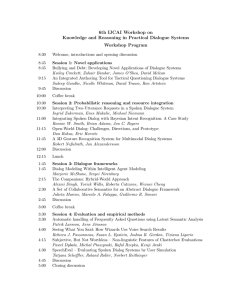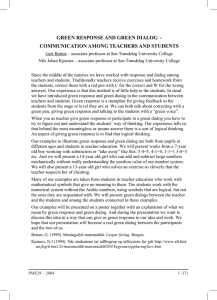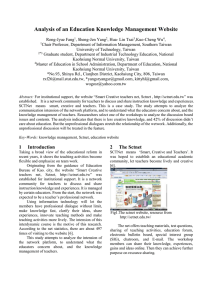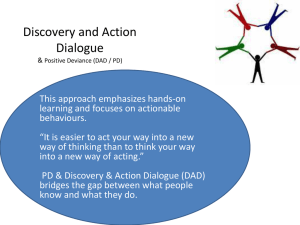REEP Lesson Plan
advertisement
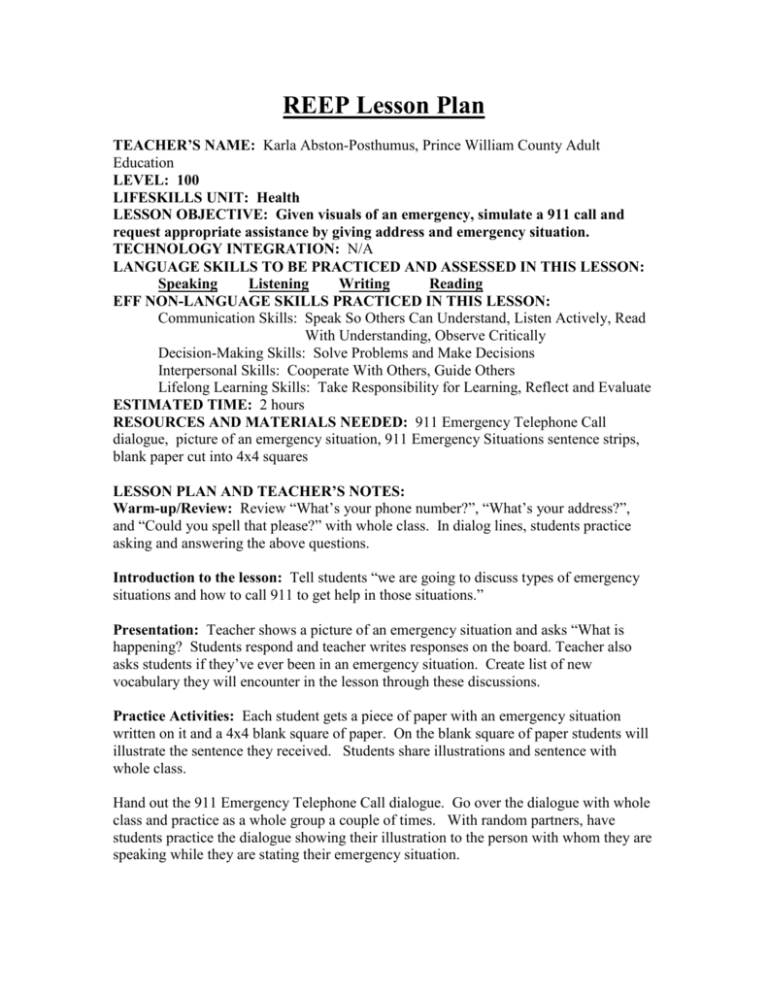
REEP Lesson Plan TEACHER’S NAME: Karla Abston-Posthumus, Prince William County Adult Education LEVEL: 100 LIFESKILLS UNIT: Health LESSON OBJECTIVE: Given visuals of an emergency, simulate a 911 call and request appropriate assistance by giving address and emergency situation. TECHNOLOGY INTEGRATION: N/A LANGUAGE SKILLS TO BE PRACTICED AND ASSESSED IN THIS LESSON: Speaking Listening Writing Reading EFF NON-LANGUAGE SKILLS PRACTICED IN THIS LESSON: Communication Skills: Speak So Others Can Understand, Listen Actively, Read With Understanding, Observe Critically Decision-Making Skills: Solve Problems and Make Decisions Interpersonal Skills: Cooperate With Others, Guide Others Lifelong Learning Skills: Take Responsibility for Learning, Reflect and Evaluate ESTIMATED TIME: 2 hours RESOURCES AND MATERIALS NEEDED: 911 Emergency Telephone Call dialogue, picture of an emergency situation, 911 Emergency Situations sentence strips, blank paper cut into 4x4 squares LESSON PLAN AND TEACHER’S NOTES: Warm-up/Review: Review “What’s your phone number?”, “What’s your address?”, and “Could you spell that please?” with whole class. In dialog lines, students practice asking and answering the above questions. Introduction to the lesson: Tell students “we are going to discuss types of emergency situations and how to call 911 to get help in those situations.” Presentation: Teacher shows a picture of an emergency situation and asks “What is happening? Students respond and teacher writes responses on the board. Teacher also asks students if they’ve ever been in an emergency situation. Create list of new vocabulary they will encounter in the lesson through these discussions. Practice Activities: Each student gets a piece of paper with an emergency situation written on it and a 4x4 blank square of paper. On the blank square of paper students will illustrate the sentence they received. Students share illustrations and sentence with whole class. Hand out the 911 Emergency Telephone Call dialogue. Go over the dialogue with whole class and practice as a whole group a couple of times. With random partners, have students practice the dialogue showing their illustration to the person with whom they are speaking while they are stating their emergency situation. Application: Each student chooses an emergency situation out of a bag (a picture or a sentence). In dialog lines, practice 911 Emergency Telephone Call. Collect pictures and sentences and mix them up in the bag. Students choose another card and practice again. (Can be repeated again if students are interested.) Evaluation Activity: Informal teacher evaluation: checking how closely illustrations match sentence; listening to conversation as students practice in dialog lines Reflection Activity: Brainstorm a list of emergency situations that students have been in and/or refer back to the list generated in the Presentation.. What did they do? Whole class discusses additional information to add based on Emergency dialog they just practiced. Extension Activities for the Classroom and Beyond: Find a picture of someone in an emergency situation and write a phone conversation for that person or give students a copy of the list of sentence strips and they can illustrate all of them at home. 911 Emergency Telephone Call A: 911. B: This is an emergency! A: What’s the emergency? B: _____________________________. A: What’s your location? B: I’m at __________________________. A: An emergency team is on the way. Please stay on the phone. 911 Emergency Situations My son drank poison. My house is on fire. My father is having a heart attack. My mother fainted. I’m having a baby. There’s a burglar in my house. There’s someone with a gun in my house. My daughter’s missing. My husband is unconscious. My wife is choking. My baby is not breathing. My husband fell off the ladder and can’t move. I just had a car accident. Someone just robbed me. I’m being carjacked. There’s somebody chasing me. There’s an aggressive driver following me. I found my child in the swimming pool and she’s not breathing.
